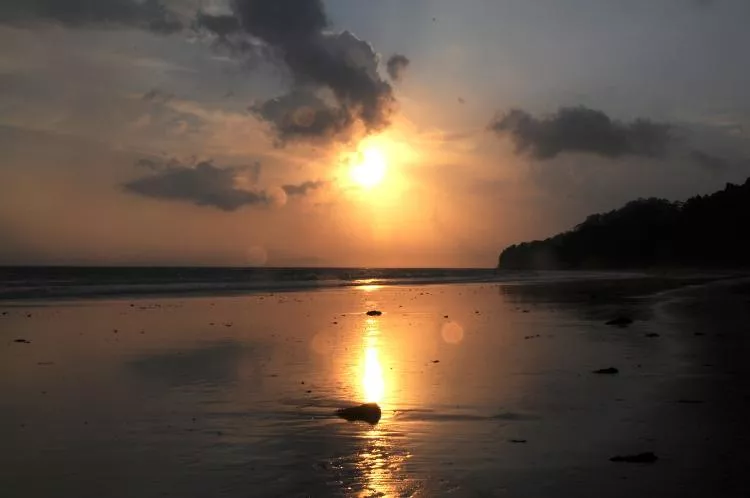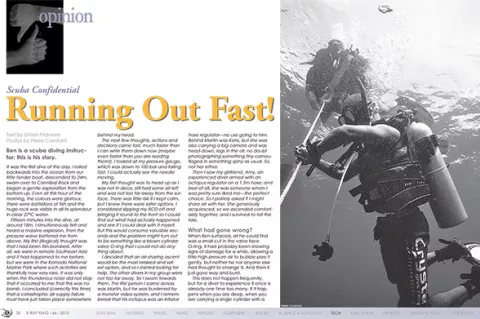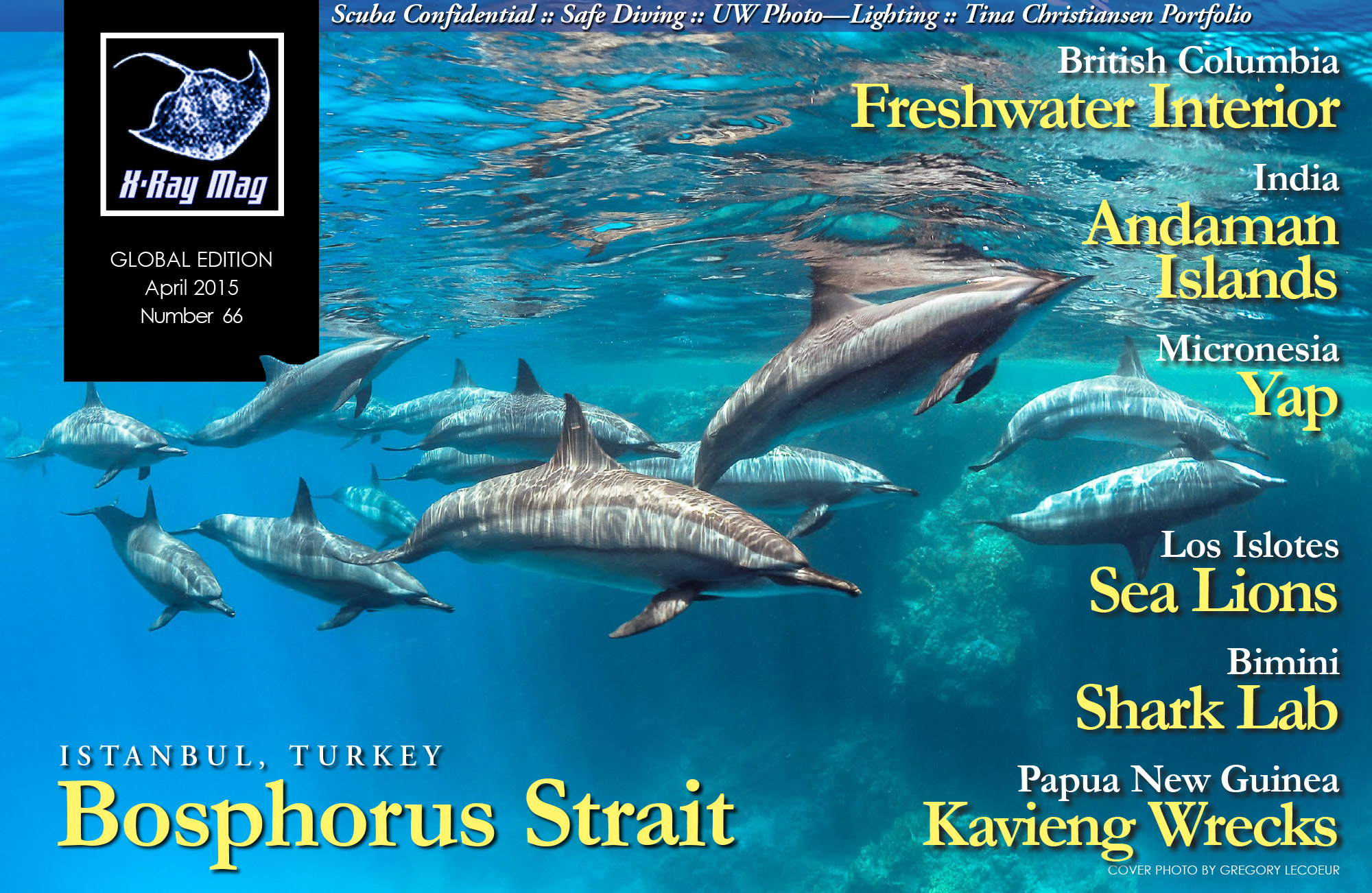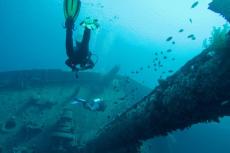Ben is a scuba diving instructor—this is his story.
Contributed by
Factfile
Simon Pridmore has been part of the scuba diving scene in Asia, Europe and the United States (well, Guam) for the past 20 years or so.
His latest book, Scuba Confidential, is available in paperback, audiobook and e-book on Amazon.
It was the first dive of the day. I rolled backwards into the ocean from our little tender boat, descended to 24m, swam over to Cannibal Rock and began a gentle exploration from the bottom up. Even at this hour of the morning, the colours were glorious; there were battalions of fish and the huge rock was visible in all its splendour in clear 27°C water.
Fifteen minutes into the dive, at around 18m, I simultaneously felt and heard a massive explosion, then the pressure wave battered me from above. My first (illogical) thought was that I had been fish-bombed. After all, we were in remote Southeast Asia and it had happened to me before, but we were in the Komodo National Marine Park where such activities are thankfully now very rare. It was only when the thunderous noise did not stop that it occurred to me that this was no bomb. I concluded (correctly this time) that a catastrophic air supply failure must have just taken place somewhere behind my head.
The next few thoughts, actions and decisions came fast, much faster than I can write them down now (maybe even faster than you are reading them!). I looked at my pressure gauge, which was down to 100 bar and falling fast. I could actually see the needle moving.
My first thought was to head up as I was not in deco, still had some air left and was not too far away from the surface. There was little risk if I kept calm, but I knew there were safer options. I considered slipping my BCD off and bringing it round to the front so I could find out what had actually happened and see if I could deal with it myself. But this would consume valuable seconds and the problem might turn out to be something like a blown cylinder valve O-ring that I could not do anything about.
I decided that an air-sharing ascent would be the most relaxed and safest option, and so I started looking for help. The other divers in my group were not too far away. So I swam towards them. The first person I came across was Martin, but he was burdened by a monster video system, and I remembered that his octopus was an inflator hose regulator—no use going to him. Behind Martin was Kate, but she was also carrying a big camera and was head-down, legs in the air, no doubt photographing something tiny camouflaged in something spiny as usual. So, not her either.
Then I saw my girlfriend, Amy, an experienced diver armed with an octopus regulator on a 1.5m hose; and best of all, she was someone whom I was pretty sure liked me—the perfect choice. So I politely asked if I might share air with her. She generously acquiesced, so we ascended comfortably together, and I survived to tell the tale.
What had gone wrong?
When Ben surfaced, all he could find was a small cut in the valve face O-ring. It had probably been showing signs of damage for a while, allowing a little high-pressure air to bubble pass it gently, but neither he nor anyone else had thought to change it. And then it just gave way and burst.
This does not happen frequently, but for a diver to experience it once is already one time too many. If it happens when you are deep, when you are carrying a single cylinder with a single valve and when you are far away from other divers, your only option is to ascend directly to the surface, as slowly as you can before the air runs out completely.
How long have you got?
As Ben’s experience suggests, a catastrophic air supply failure can empty your cylinder in a very short time. Part of this time will be spent figuring out what has happened, weighing up the possibilities and deciding what course of action to take. At depth, these processes will be delayed by narcosis.
In 2012, the folk at Advanced Diver magazine in the USA ran a few scenarios using a standard set of equipment on a full 12-litre cylinder placed at a depth of 30m. They found that a burst high-pressure hose caused the cylinder to empty in 22 minutes. No problem there—plenty of time to surface safely.
However, they also found that a burst low-pressure hose or a blown burst disc on the cylinder valve emptied the cylinder in under 90 seconds! An uncontrolled free-flowing regulator did not take much longer, causing the cylinder pressure to plummet from 200 bar to zero in just 154 seconds.
Even at 18m, Ben probably would not have had time to reach the surface at a safe ascent rate before his air ran out.
What can you do?
- Replace all O-rings as soon as you notice bubbles, and replace hoses as soon as you notice significant wear. This is something that technical divers, and particularly rebreather divers, are trained to do but the mainstream sport diving community is notoriously lax. It is not uncommon to see a group of divers patrolling the reef with bubbles spewing out from everywhere: tank valves, high pressure hoses, octopus second stages, even BCD dump valves.
- For deep dives, even if no decompression stops are planned, consider genuine alternate air source options, such as a pony cylinder, a dual outlet valve, double cylinders or even a Spare Air.
- Practise rescue scenarios with your regular dive partner(s) and make sure you and they, like Ben’s girlfriend, are properly equipped with a long regulator hose to allow a comfortable, safe ascent.
- If you regularly dive alone on a single cylinder, practise self-rescue scenarios. One course of action Ben could have taken during the incident was to slip off his BCD, bring it around in front of him and turn off the cylinder valve. Then, as he ascended holding his equipment, he could open the valve slightly to take each breath, then turn it off to conserve air while he exhaled. However, this is a difficult skill. It needs to be practised several times with a dive buddy close at hand—be sure to completely master this before you even think about doing this in an emergency.
■
























